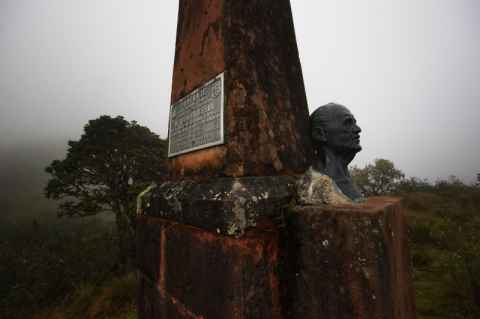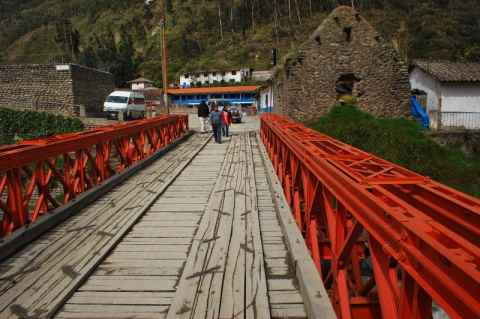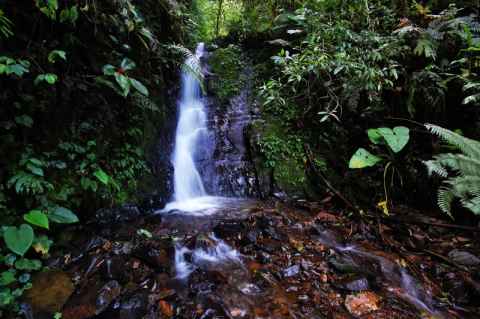Manu National Park
"The way I look at these things", J. explained, "is that they are all planned and designed for fat Americans. They are the ones with money, after all. Who would plan a tour with skinny, miserly Europeans in mind? They're not paying!"
I was thinking about the upcoming four-day tour to the Manu National Park. We had booked the tour with Machete Tours[a], but now, two days before the tour was to start, I realized I had no clue what would be expected of me on it. Would we carry all our stuff - food, water and all - on hikes, or would we only carry day packs? What about the sleeping bags we would rent - would we haul them as well? Would there be electricity at the lodges to recharge the GPS and camera batteries?
The answers turned out to be "day packs", "no sleeping bags needed" and "only at the first one" - but let me explain how this tour worked.
With two paying people on the tour, five people in total go: The two tourists, a guide, a cook and a driver. Everything not part of the day pack is carried on vehicles - a car or a boat - to the lodge where everyone stays. The activities are scheduled as an optional pre-breakfast activity (for things such as watching Macaw clay licks[b], which happen very early in the morning), a morning activity (a hike, for example), then lunch, and an afternoon activity, followed by dinner. Then it's sleep time.
What Went Right and What Went Wrong
I can happily report that by and large, just about everything went right. The mosquito nets worked, our clothes and backpacks and cameras and tripods worked. My only regret is best illustrated by this graphic:
Somehow I had overlooked the fact that there is no electricity in the jungle. No electricity means no charging of batteries. In Stockholm I can go out and get a spare battery in under half an hour, in Lima I spent a day trying to find one, but to no avail. Getting batteries for the newer D3100 was no problem, but for the D40 - forget it, no camera store had it, and on Nikon Peru[c]'s website, it is listed with a "Notify" sign[d], which I assume means "not in stock":
The result was that I had to conserve battery power all the time; bringing on the agony of seeing an opportunity develop and then pass by as I think, in order: "No, this isn't worth wasting power on...", "...oh wait it is...", "...too late.". As it were, the battery lasted just about to the end of the last hike, so it all turned out more or less all right in the end, with the exception of some missed shots that I'll just have to settle to have experienced without looking through a viewfinder - but I would have wanted the comfort of knowing that I had a second battery ready to go.
The Tour Begins
Early in the morning we set off on a bumpy road toward Manu. The first surprise would come at the park entrance.
On a muddy hilltop in Peru, shrouded in fog, we come upon an obelisk and a bust of someone. The plaque reads:

2012-01-07 10:24
Manu National Park Entrance, Peru 2011, Peruvian Amazon 2011, Sven Ericsson Bridge
The plaque reads:
Homenaje
a la memoria del eminente
benefactor de Paucartambo
Dr. Sven Ericsson
Quien con su incansable labor hizo posible
la construccion de la carretera Huambutio-
Madre de Dios.
La provincia, sus amigos y el consul de
Suecia Sr. Gösta Borenius
Paucartambo 13 de mayo 1,967
In English:
Tribute
to the memory of the eminent
benefactor of Paucartambo
Dr. Sven Ericsson
Who with his untiring efforts made it possible
to construct the road from Huambutio-
Madre de Dios.
The province, his friends and the consul of
Sweden Mr. Gösta Borenius
Paucartambo, May 13, 1967
So some Swede had been here before us - and apparently done something worthy of a memorial. Some research turned up the following:
Mathematician and biologist from Sweden. Sven Ericsson, along with other explorers, in at up to Itahuanía Q'osñipata. Research studies on the flora with the existence of caoutchouc and rubber. Proposed to link the railway station and Itahuaniadel Paucartambo Huambutio with the upper Madre de Dios river, through a penetration road (320 kms).
Matemático y biólogo de nacionalidad sueca. Sven Ericsson, junto con otros exploradores, se adentro en Q'osñipata hasta llegar a Itahuania. Realizo estudios de investigación sobre la flora con la existencia del caucho y goma. Propuso enlazar la estación ferroviaria de Huambutio con Paucartambo e Itahuaniadel alto Madre de Dios, a través de una carretera de penetración (320 Kms.).
— "7. Evolucion Historica", chapter from unknown book, p. 18[e]
But it turns out that our intrepid Sven Ericsson also has a bridge in Paucartambo named after him.

2012-01-07 09:11
Manu National Park Entrance, Peru 2011, Peruvian Amazon 2011, Sven Ericsson Bridge
It is a metal bridge (27.50 meters) built on the Paucartambo river in 1981 (during the administration of Mayor Leonard Luisa Figueroa). It is located a hundred yards downstream of the Carlos III bridge. Named after the benefactor Sven Ericsson Liquet.
Es un puente metálico (27.50 metros lineales) construido sobre el rio Paucartamboen 1981 (durante la gestión de la alcaldesa Luisa Figueroa de Leonard). Estáubicado, rio abajo, a cien metros del puente Carlos III. Lleva el nombre del benefactor Sven Ericsson Liquet.
— "7. Evolucion Historica", chapter from unknown book, p. 24[f]
On the way down through the cloud forest we saw a waterfall.

2012-01-07 14:08
Manu National Park Entrance, Peru 2011, Peruvian Amazon 2011, Sven Ericsson Bridge